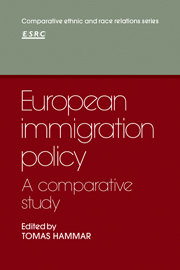11 - The policymaking process
Published online by Cambridge University Press: 05 November 2011
Summary
This chapter discusses how immigration policy is made. Unlike the previous chapters, here we are interested in the origin and form of policy rather than in its content. Though all six of the project countries are democracies where two or more parties compete in free elections, each is governed in a different fashion and has its own particular kinds of institutions and traditions. The parliamentary system of Britain stands in contrast to the presidential system of France; the centralized French system of decisionmaking stands in contrast to the decentralized Swiss system, with its autonomous cantons and local authority, as well as to the federal system of Germany; the multiparty system of the Netherlands stands in contrast to the traditional two-party system of Britain. Despite these considerable differences in political systems, however, there are significant similarities in how immigration policy is made. This chapter will examine those similarities.
Policy or “non-policy”
German politicians have emphatically declared that their country is not a country of immigration. This declaration comes as somewhat of a surprise to foreign observers, who note that approximately four million foreign citizens reside in the Federal Republic. The Germans have answered that these foreign citizens, originally recruited as labor, should be regarded as temporary “guestworkers”; in other words, no plans have ever been made in Germany for permanent immigration. The number of foreign workers has become large only because the economy required extra manpower during a period of transition.
- Type
- Chapter
- Information
- European Immigration PolicyA Comparative Study, pp. 277 - 291Publisher: Cambridge University PressPrint publication year: 1985
- 1
- Cited by



